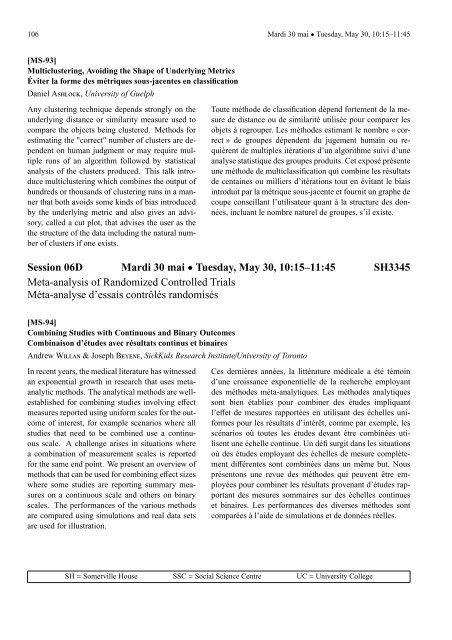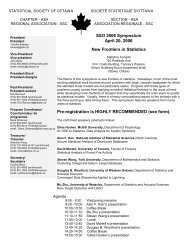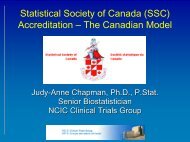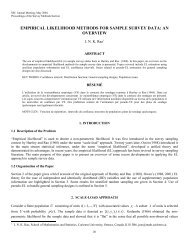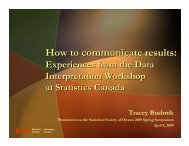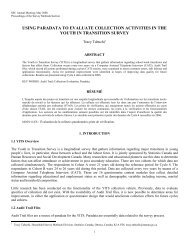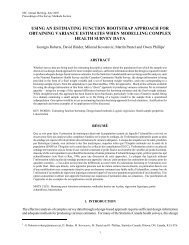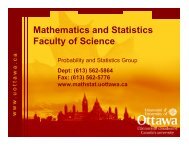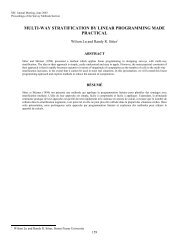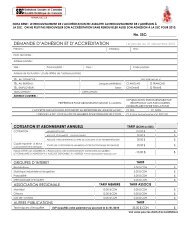Programme et résumés (pdf) - Société statistique du Canada
Programme et résumés (pdf) - Société statistique du Canada
Programme et résumés (pdf) - Société statistique du Canada
You also want an ePaper? Increase the reach of your titles
YUMPU automatically turns print PDFs into web optimized ePapers that Google loves.
106 Mardi 30 mai • Tuesday, May 30, 10:15–11:45[MS-93]Multiclustering, Avoiding the Shape of Underlying M<strong>et</strong>ricsÉviter la forme des métriques sous-jacentes en classificationDaniel ASHLOCK, University of GuelphToute méthode de classification dépend fortement de la mesurede distance ou de similarité utilisée pour comparer lesobj<strong>et</strong>s à regrouper. Les méthodes estimant le nombre « cor-rect » de groupes dépendent <strong>du</strong> jugement humain ou re-quièrent de multiples itérations d’un algorithme suivi d’uneanalyse <strong>statistique</strong> des groupes pro<strong>du</strong>its. C<strong>et</strong> exposé présenteune méthode de multiclassification qui combine les résultatsde centaines ou milliers d’itérations tout en évitant le biaisintro<strong>du</strong>it par la métrique sous-jacente <strong>et</strong> fournit un graphe decoupe conseillant l’utilisateur quant à la structure des don-nées, incluant le nombre naturel de groupes, s’il existe.Any clustering technique depends strongly on theunderlying distance or similarity measure used tocompare the objects being clustered. M<strong>et</strong>hods forestimating the "correct" number of clusters are dependenton human judgment or may require multipleruns of an algorithm followed by statisticalanalysis of the clusters pro<strong>du</strong>ced. This talk intro<strong>du</strong>cemulticlustering which combines the output ofhundreds or thousands of clustering runs in a mannerthat both avoids some kinds of bias intro<strong>du</strong>cedby the underlying m<strong>et</strong>ric and also gives an advisory,called a cut plot, that advises the user as th<strong>et</strong>he structure of the data including the natural numberof clusters if one exists.Session 06D Mardi 30 mai • Tuesday, May 30, 10:15–11:45 SH3345M<strong>et</strong>a-analysis of Randomized Controlled TrialsMéta-analyse d’essais contrôlés randomisés[MS-94]Combining Studies with Continuous and Binary OutcomesCombinaison d’études avec résultats continus <strong>et</strong> binairesAndrew WILLAN & Joseph BEYENE, SickKids Research Institute/University of TorontoIn recent years, the medical literature has witnessedan exponential growth in research that uses m<strong>et</strong>aanalyticm<strong>et</strong>hods. The analytical m<strong>et</strong>hods are wellestablishedfor combining studies involving effectmeasures reported using uniform scales for the outcomeof interest, for example scenarios where allstudies that need to be combined use a continuousscale. A challenge arises in situations wherea combination of measurement scales is reportedfor the same end point. We present an overview ofm<strong>et</strong>hods that can be used for combining effect sizeswhere some studies are reporting summary measureson a continuous scale and others on binaryscales. The performances of the various m<strong>et</strong>hodsare compared using simulations and real data s<strong>et</strong>sare used for illustration.Ces dernières années, la littérature médicale a été témoind’une croissance exponentielle de la recherche employantdes méthodes méta-analytiques. Les méthodes analytiquessont bien établies pour combiner des études impliquantl’eff<strong>et</strong> de mesures rapportées en utilisant des échelles uni-formes pour les résultats d’intérêt, comme par exemple, lesscénarios où toutes les études devant être combinées uti-lisent une échelle continue. Un défi surgit dans les situationsoù des études employant des échelles de mesure complète-ment différentes sont combinées dans un même but. Nousprésentons une revue des méthodes qui peuvent être em-ployées pour combiner les résultats provenant d’études rap-portant des mesures sommaires sur des échelles continues<strong>et</strong> binaires. Les performances des diverses méthodes sontcomparées à l’aide de simulations <strong>et</strong> de données réelles.SH = Somerville House SSC = Social Science Centre UC = University College


